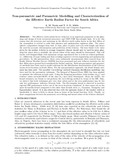"Non-Parametric and Parametric Modeling and Characterization of the Effective Earth Radius Factor for South Africa

View/
Date
2013Author
Nyete, A M
Afullo, T J O
Type
ArticleLanguage
enMetadata
Show full item recordAbstract
The e®ective earth radius factor (k-factor) is an important parameter in the plan-
ning and design of both terrestrial microwave and UHF/VHF line-of-sight links. It is for this
reason that the structure and variations in the e®ective earth radius factor in the ¯rst 200m of
the atmosphere is critical to radio link planners and optimization engineers alike. The atmo-
spheric composition changes from time to time, place to place and even with height and hence
the need for accurate determination and prediction of the k-factor. The four thirds (4/3) value
given for the median k-factor in average temperate climate should only be used for gross plan-
ning but where data is available, the actual values of the same should be determined. This will
ensure well designed links with minimum outage experienced due to k-factor related problems,
i.e., di®raction (k-type) fading and thus avoiding expensive reverse engineering and optimization
procedures. In this presentation, three years radiosonde measurements data sourced from the
South African Weather Service (SAWS) has been processed and only k-factor statistics for the
¯rst 200m above ground level considered for further analysis. Both non-parametric and paramet-
ric methods have been used to model solutions for the distribution characteristics of the k-factor
across seven locations in South Africa. For the non-parametric approach, the kernel density esti-
mate has been used. The so-called `curve-¯tting' method (Gaussian distribution modelling) has
been used for the parametric technique. The Integral of Squared Error (ISE) has been applied
to optimize the solutions in both cases. Using the foregoing procedures, both median (k50%) and
k-factor values exceeded 99.9% of the time (ke) have been determined. From the results, the
kernel estimates are found to out-perform the curve-¯tting method in terms of the ISE. Also,
we observe that both techniques give very close values and so the error performance may be the
only key performance indicator between both. The Rectangular kernel is observed to produce
superior ISE performance in ¯ve out of the seven locations considered. It thus comes out as the
more favourable kernel compared to the other three kernels used, i.e., Gaussian, Triangular and
Epanechnikov kernel. It is also observed that with the optimum choice of the window width or
bandwidth, h, there is little to choose from in terms of the kernel function, K(k). Finally, we
draw comparisons between the measured, curve-¯tting and kernel values of the k-factor obtained.
Citation
Progress In Electromagnetics Research Symposium Proceedings, Taipei, March 25{28, 2013Publisher
University of Nairobi Department of Electrical, Electronic and Computer Engineering
